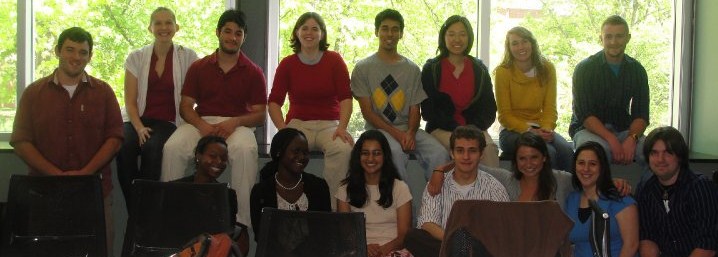Team:Virginia United/Team
From 2010.igem.org
| Line 136: | Line 136: | ||
*'''Student 8''': Brett Tolliver | *'''Student 8''': Brett Tolliver | ||
*'''Student 9''': Daniel Chique | *'''Student 9''': Daniel Chique | ||
| - | *'''Student 10''' | + | *'''Student 10''' |
| + | <a href="https://2010.igem.org/Virginia_Tech_and_Bluefield_State_Members">Dasha Nesterova | ||
</a>Dasha Nesterova | </a>Dasha Nesterova | ||
*'''Student 11''': Jane Carter | *'''Student 11''': Jane Carter | ||
Revision as of 22:46, 26 October 2010

Who we are
What we didQuorum Sensing Amplifiers and a Codesign Approach for Information Processing Synthetic biology endeavors to create information processing systems modeled on digital electronics. The use of quorum sensing can help transform an inherently analog molecular signal into a binary response and simultaneously allow the tuning of input response thresholds and signal amplification. This project demonstrates these capabilities through experimentation and modeling. Another candidate for reapplying an electronic engineering technique is the codesign of hardware and software to implement a function. In synthetic biology, codesign might mean implementing a design specification in different expression control regimes and comparing their relative merits. Our work examines the codesign concept by constructing an AND gate in three different design domains. We explore the application of these ideas with an environmental sensor. A unique aspect of our project is the collaborative nature involving five institutions at three locations, which fostered a codesign-like approach using two distinct assembly techniques. Where we're fromVirginia United is a regional team between Virginia Tech, University of Virginia, Virginia Commonwealth University, Bluefield State College, and Virginia State University. The team members spent their summer spread between labs at Virginia Tech, University of Virginia, and Virginia Commonwealth University working towards a common project. Regional TeamThe Virginia United Team was created as a collaborative effort between five schools, University of Virginia, Virginia Commonwealth University, Virginia Polytechnic Institute and State University (Virginia Tech), Bluefield State College, and Virginia State University. We divided up and worked on separate parts of the project in three different locations in the state and maintained communication through constant emails, Skype calls, and face to face regional meetings. Collaborating on a project of this magnitude with this many people involved was in itself an experimental endeavor that challenged us to develop a project and maintain strong communication and organizational skills that are vital to the interdisciplinary component of synthetic biology. Not only did each individual have something unique to offer to the team, but so did each individual university based on their access to resources that other schools might have lacked. Perhaps one of the most vital components of this project is what we learned from working together to help develop a project that we would not have been able to accomplish individually. Having gained a better understanding of how research can be conducted in a huge group setting has provided us with the experience that will really become instrumental in our future in research and in particular synthetic biology as the need for collaborative projects between schools, states, and even countries becomes a normal part of the research world. Collaborations with Other TeamsWe helped the software team create a program that can analyze a construct's DNA sequence and design oligo primers that can be used for USER fusion. Our team helped by explaining how USER fusion works, explaining optimal length of primers, and explaining optimal melting temperatures for the primers. USER fusion is a method for splicing together long strands of DNA and is convenient for construct assembly.
| |||||||||
 "
"





